Conceptual Design of a Floating Modular Energy Island for Energy Independency: A Case Study in Crete
Abstract
1. Introduction
2. Assessment of Renewable Energy Resources for Potential Location
2.1. Wind Energy Assessment
2.2. Solar Energy Assessment
2.3. Wave Energy Assessment
3. Potential Location and Considerations for Energy Islands
4. Conceptual Design of the Energy Island
4.1. Floating Wind Turbine
4.2. Floating Photovoltaic Structure
4.3. Wave Energy Converter
4.4. Energy Production
4.5. Design of the Energy Island
5. Conclusions
Author Contributions
Funding
Data Availability Statement
Acknowledgments
Conflicts of Interest
References
- European Commission, Directorate-General for Energy. An EU Strategy to Harness the Potential of Offshore Renewable Energy for a Climate Neutral Future; European Union: Brussels, Belgium, 2020. [Google Scholar]
- Keiner, D.; Salcedo-Puerto, O.; Immonen, E.; van Sark, W.G.; Nizam, Y.; Shadiya, F.; Duval, J.; Delahaye, T.; Gulagi, A.; Breyer, C. Powering an island energy system by offshore floating technologies towards 100% renewables: A case for the Maldives. Appl. Energy 2022, 308, 118360. [Google Scholar]
- Fujikubo, M.; Suzuki, H. Mega-Float. In Large Floating Structures. Ocean Engineering & Oceanography; Springer: Singapore, 2015; Volume 3, pp. 197–219. [Google Scholar]
- Nakamura, K.; Mueller, G. Review of the performance of the artificial floating island as a restoration tool for aquatic environments. In Proceedings of the World Environmental and Water Resources Congress 2008: Ahupua’A, Honolulu, HI, USA, 12–16 May 2008; pp. 1–10. [Google Scholar]
- Wang, C.; Tay, Z. Very large floating structures: Applications, research and development. Procedia Eng. 2011, 14, 62–72. [Google Scholar]
- Yeh, N.; Yeh, P.; Chang, Y.-H. Artificial floating islands for environmental improvement. Renew. Sustain. Energy Rev. 2015, 47, 616–622. [Google Scholar] [CrossRef]
- Drummen, I.; Olbert, G. Conceptual design of a modular floating multi-purpose island. Front. Mar. Sci. 2021, 8, 615222. [Google Scholar] [CrossRef]
- Frankel, G.E. Prefabricated and Relocatable Artificial Island Technology. In Macro-Engineering; Davidson, F.P., Frankel, E.G., Meador, C.L., Eds.; Woodhead Publishing: Cambridge, UK, 1997; pp. 155–173. [Google Scholar]
- Danish Energy Agency. Energy Islands in the North Sea. Available online: https://ens.dk/en/our-responsibilities/energy-islands/energy-island-north-sea (accessed on 25 July 2023).
- Dimitris, K.; Ioannis, A.; Irini, D.; Dimitris, C. Turning Crete into an energy independent island. In Proceedings of the 4th International Hybrid Power Systems Workshop, Crete, Greece, 22–23 May 2019. [Google Scholar]
- United Nations. Sustainable Development Goals–United Nations. Available online: http://www.un.org/sustainabledevelopment/sustainable-development-goals/ (accessed on 27 October 2022).
- European Cooperation in Science and Technology (COST). MODENERLANDS. Available online: https://modenerlands.eu/about/ (accessed on 28 October 2022).
- New European Wind Atlas (NEWA) Is Licensed under CC BY 4.0. Available online: https://map.neweuropeanwindatlas.eu/ (accessed on 28 September 2022).
- New European Wind Atlas (NEWA). About. Available online: https://map.neweuropeanwindatlas.eu/about (accessed on 7 January 2023).
- Witha, B.; Hahmann, A.; Sile, T.; Dörenkämper, M.; Ezber, Y.; García-Bustamante, E.; González-Rouco, J.F.; Leroy, G.; Navarro, J. WRF Model Sensitivity Studies and Specifications for the NEWA Mesoscale Wind Atlas Production Runs; New European Wind Atlas Report Zenodo. 2019. Available online: https://zenodo.org/record/2682604 (accessed on 7 January 2023).
- Bailey, B.H.; Scott, L. Wind Resource Assessment Handbook; AWS Scientific, Inc.: Albany, NY, USA, 1997. [Google Scholar]
- Global Solar Atlas. Solargis. Licensed under CC BY 4.0. Available online: https://globalsolaratlas.info/map?c=37.09024,23.307495,7&a=20.147043,34.709105,20.147043,39.398848,26.661333,39.398848,26.661333,34.709105,20.147043,34.709105&s=35.717974,23.584407&m=site (accessed on 17 July 2023).
- Seyboth, K.; Matschoss, P.; Kadner, S.; Zwickel, T.; Eickemeier, P.; Hansen, G.; Schlömer, S.; Stechow, C.V. Renewable Energy Sources and Climate Change Mitigation. Special Report of the Intergovernmental Panel on Climate Change; Cambridge University Press: Cambridge, UK, 2012. [Google Scholar]
- Ayat, B. Wave Power Atlas of Eastern Mediterranean and Aegean Seas. Energy 2013, 54, 251–262. [Google Scholar] [CrossRef]
- Lavidas, G.; Venugopal, V. A 35 Year High-Resolution Wave Atlas for Nearshore Energy Production and Economics at the Aegean Sea. Renew. Energy 2017, 103, 401–417. [Google Scholar] [CrossRef]
- Jadidoleslam, N.; Özger, M.; Ağiralioğlu, N. Wave Power Potential Assessment of Aegean Sea with an Integrated 15-Year Data. Renew. Energy 2016, 86, 1045–1059. [Google Scholar] [CrossRef]
- Zacharioudaki, A.; Korres, G.; Perivoliotis, L. Wave Climate of the Hellenic Seas Obtained from a Wave Hindcast for the Period 1960–2001. Ocean. Dyn. 2015, 65, 795–816. [Google Scholar] [CrossRef]
- Foteinis, S.; Tsoutsos, T.; Synolakis, C. Numerical Modelling for Coastal Structures Design and Planning. A Case Study of the Venetian Harbour of Chania, Greece. Int. J. Geoengin. Case Hist. 2018, 4, 232–241. [Google Scholar]
- Mediterranean Sea Waves Reanalysis, Copernicus Marine Service, Copernicus. Available online: https://data.marine.copernicus.eu/product/MEDSEA_MULTIYEAR_WAV_006_012/description?view=-&task=results&product_id=-&option=- (accessed on 17 July 2023).
- Ministry of Environment, Energy and Climate Change (MEECC). Specific Framework for Spatial Planning and Sustainable Development for Renewable Energy Sources. JMD 49828/2008, OGHE B’ 2464/3-12-08; MEECC: Athens, Greece, 2008. [Google Scholar]
- Lloret, J.; Turiel, A.; Sole, J.; Berdalet, E.; Sabates, A.; Olivares, A.; Gili, J.-M.; Vila-Subiros, J.; Sarda, R. Unravelling the ecological impacts of large-scale offshore wind farms in the Mediterranean Sea. Sci. Total Environ. 2022, 824, 153803. [Google Scholar] [CrossRef]
- Vasileiou, M.; Loukogeorgaki, E.; Vagiona, D.G. GIS-based multi-criteria decision analysis for site selection of hybrid offshore wind and wave energy systems in Greece. Renew. Sustain. Energy Rev. 2017, 73, 745–757. [Google Scholar] [CrossRef]
- Vagiona, D.G.; Kamilakis, M. Sustainable site selection for offshore wind farms in the South Aegean-Greece. Sustainability 2018, 10, 749. [Google Scholar] [CrossRef]
- Möller, B. Continuous spatial modelling to analyse planning and economic consequences of offshore wind energy. Energy Policy 2011, 39, 511–517. [Google Scholar] [CrossRef]
- Human Activities—Military Areas, EMODnet. Available online: https://emodnet.ec.europa.eu/geoviewer/?layers=12444:1:1,12443:1:1&basemap=esri-imagery&active=12444&bounds=20.387568850501644,34.15593868958256,28.276434013332725,37.756300040937425&filters= (accessed on 17 July 2023).
- Human Activities—Cargo, EMODnet. Available online: https://emodnet.ec.europa.eu/geoviewer/?layers=12963:1:1,12763:1:1,12717:1:1&basemap=esri-imagery&active=12963&bounds=20.604422241192978,33.855624450948575,28.38690765020506,37.40743565645723&filters= (accessed on 17 July 2023).
- Human Activities—Cables, EMODnet. Available online: https://emodnet.ec.europa.eu/geoviewer/?layers=12439:1:1,10180:1:1&basemap=esri-imagery&active=12439&bounds=20.604422241192978,33.855624450948575,28.38690765020506,37.40743565645723&filters= (accessed on 17 July 2023).
- Human Activities—Nature 2000 Sites, EMODnet. Available online: https://emodnet.ec.europa.eu/geoviewer/?layers=12517:1:1&basemap=esri-imagery&active=12517&bounds=20.604422241192978,33.855624450948575,28.38690765020506,37.40743565645723&filters= (accessed on 17 July 2023).
- Ng, C.; Ran, L. Offshore Wind Farms: Technologies, Design and Operation; Woodhead Publishing: Duxford, UK, 2016. [Google Scholar]
- Murphy, J.; Lynch, K.; Serri, L.; Airdoldi, D.; Lopes, M. Site Selection Analysis for Offshore Combined Resource Projects in Europe. In Report of the Off-Shore Renewable Energy Conversion Platforms—Coordination Action (ORECCA) Project. 2011. Available online: http://orecca.rse-web.it/doc_info/Site_Selection_Analysis_Report.pdf (accessed on 16 January 2023).
- Bathymetry, EMODnet. Available online: https://emodnet.ec.europa.eu/geoviewer/?layers=13004:1:1&basemap=ebwbl&active=13004&bounds=20.604422241192978,33.855624450948575,28.38690765020506,37.40743565645723&filters= (accessed on 17 July 2023).
- EuroAsia Interconnector. Available online: https://euroasia-interconnector.com/at-glance/ (accessed on 16 January 2023).
- EuroAfrica Interconnector. Available online: https://www.euroafrica-interconnector.com/at-glance/ (accessed on 16 January 2023).
- Myhr, A.; Bjerkseter, C.; Ågotnes, A.; Nygaard, T.A. Levelised cost of energy for offshore floating wind turbines in a life cycle perspective. Renew. Energy 2014, 66, 714–728. [Google Scholar] [CrossRef]
- Google Earth Version 9.191.0.0, Google Imagery 2015, 35°59′, 5°18. Available online: https://earth.google.com/web/@35.62533553,23.87668561,-71.11381736a,416802.83010475d,30.00004904y,3.28879468h,0t,0r/data=MikKJwolCiExTFp6R2QwYXpyQ1lhUU5yNTB6WlJJM2VDZFFPYTVLTm4gAQ (accessed on 15 November 2022).
- Sullivan, R.G.; Kirchler, L.B.; Cothren, J.; Winters, S.L. Offshore Wind Turbine Visibility and Visual Impact Threshold Distances. Environ. Pract. 2013, 15, 33–49. [Google Scholar] [CrossRef]
- Vermeer, L.J.; Sørensen, J.N.; Crespo, A. Wind turbine wake aerodynamics. Prog. Aerosp. Sci. 2003, 39, 467–510. [Google Scholar] [CrossRef]
- Marmidis, G.; Lazarou, S.; Pyrgioti, E. Optimal placement of wind turbines in a wind park using Monte Carlo simulation. Renew. Energy 2008, 33, 1455–1460. [Google Scholar] [CrossRef]
- Meyers, J.; Meneveau, C. Optimal turbine spacing in fully developed wind farm boundary layers. Wind. Energy 2012, 15, 305–317. [Google Scholar] [CrossRef]
- Stevens, R.J.; Gayme, D.F.; Meneveau, C. Effects of turbine spacing on the power output of extended wind-farms. Wind. Energy 2016, 19, 359–370. [Google Scholar] [CrossRef]
- Chen, J.; Hu, Z.; Duan, F. Comparisons of dynamical characteristics of a 5 MW floating wind turbine supported by a spar-buoy and a semi-submersible using model testing methods. J. Renew. Sustain. Energy 2018, 10, 053311. [Google Scholar] [CrossRef]
- Claus, R.; López, M. Key issues in the design of floating photovoltaic structures for the marine environment. Renew. Sustain. Energy Rev. 2022, 164, 112502. [Google Scholar] [CrossRef]
- NRG Island, Floating Solar. NRG Island. Available online: https://www.nrgisland.com/ (accessed on 14 November 2022).
- Wave Dragon ApS. Wave Dragon. Available online: https://wavedragon.net (accessed on 27 March 2023).
- Guillou, N.; Chapalin, G. Annual and seasonal variabilities in the performances of wave energy converters. Energy 2018, 165 Pt B, 812–823. [Google Scholar] [CrossRef]
- Veigas, M.; Iglesias, G. Potentials of a hybrid offshore farm for the islands of Fuerteventura. Energy Convers. Manag. 2014, 86, 300–308. [Google Scholar] [CrossRef]
- Veigas, M.; Lopez, M.; Romillo, P.; Carballo, R.; Castro, A.; Iglesias, G. A proposed wave farm on the Galician coast. Energy Convers. Manag. 2015, 99, 102–111. [Google Scholar] [CrossRef]
- Gigantidou, A. Crete Power System. In Proceedings of the 4th International Hybrid Power Systems Workshop, Crete, Greece, 22–23 May 2019. [Google Scholar]
- Dunnet, D.; Wallace, J.S. Electricity generation from wave power in Canada. Renew. Energy 2009, 34, 179–195. [Google Scholar] [CrossRef]
- Diaz, B.D.; Rasulo, M.; Aubeny, C.P.; Fontana, C.M.; Arwade, S.R.; DeGroot, D.J.; Landon, M. Multiline anchors for floating offshore wind towers. In Proceedings of the OCEANS 2016 MTS/IEEE Monterey, Monterey, CA, USA, 19–23 September 2016; IEEE: Piscataway, NJ, USA; pp. 1–9. [Google Scholar]
- Jonkman, J.M. Dynamics Modeling and Loads Analysis of an Offshore Floating Wind Turbine; NREL/TP-500-41958; National Renewable Energy Laboratory (NREL): Golden, CO, USA, 2007. [Google Scholar]
- Sunflex Photovoltaic System, Dock Marine Systems. Available online: https://www.dockmarine-europe.eu/en/sunflex-photovoltaic-systems (accessed on 22 June 2023).
- Pakenham, B.; Ermakova, A.; Mehmanparast, A. A Review of Life Extension Strategies for Offshore Wind Farms Using Techno-Economic Assessments. Energies 2021, 14, 1936. [Google Scholar] [CrossRef]
- Ghigo, A.; Faraggiana, E.; Sirigu, M.; Mattiazzo, G.; Bracco, G. Design and Analysis of a Floating Photovoltaic System for Offshore Installation: The Case Study of Lampedusa. Energies 2022, 15, 8804. [Google Scholar] [CrossRef]
- Ghigo, A.; Cottura, L.; Caradonna, R.; Bracco, G.; Mattiazzo, G. Platform Optimization and Cost Analysis in a Floating Offshore Wind Farm. J. Mar. Sci. Eng. 2020, 8, 835. [Google Scholar] [CrossRef]
- Baca, E.; Philip, R.T.; Greene, D.; Battey, H. Expert Elicitation for Wave Energy LCOE Futures; Technical Report NREL/TP-5700-82375; National Renewable Energy Laboratory (NREL): Golden, CO, USA, 2022. [Google Scholar]
- Jelic, M.; Batic, M.; Tomasevic, N.; Barney, A.; Polatidis, H.; Crosbie, T.; Ghanem, D.A.; Short, M.; Pillai, G. Towards Self-Sustainable Island Grids through Optimal Utilization of Renewable Energy Potential and Community Engagement. Energies 2020, 13, 3386. [Google Scholar] [CrossRef]

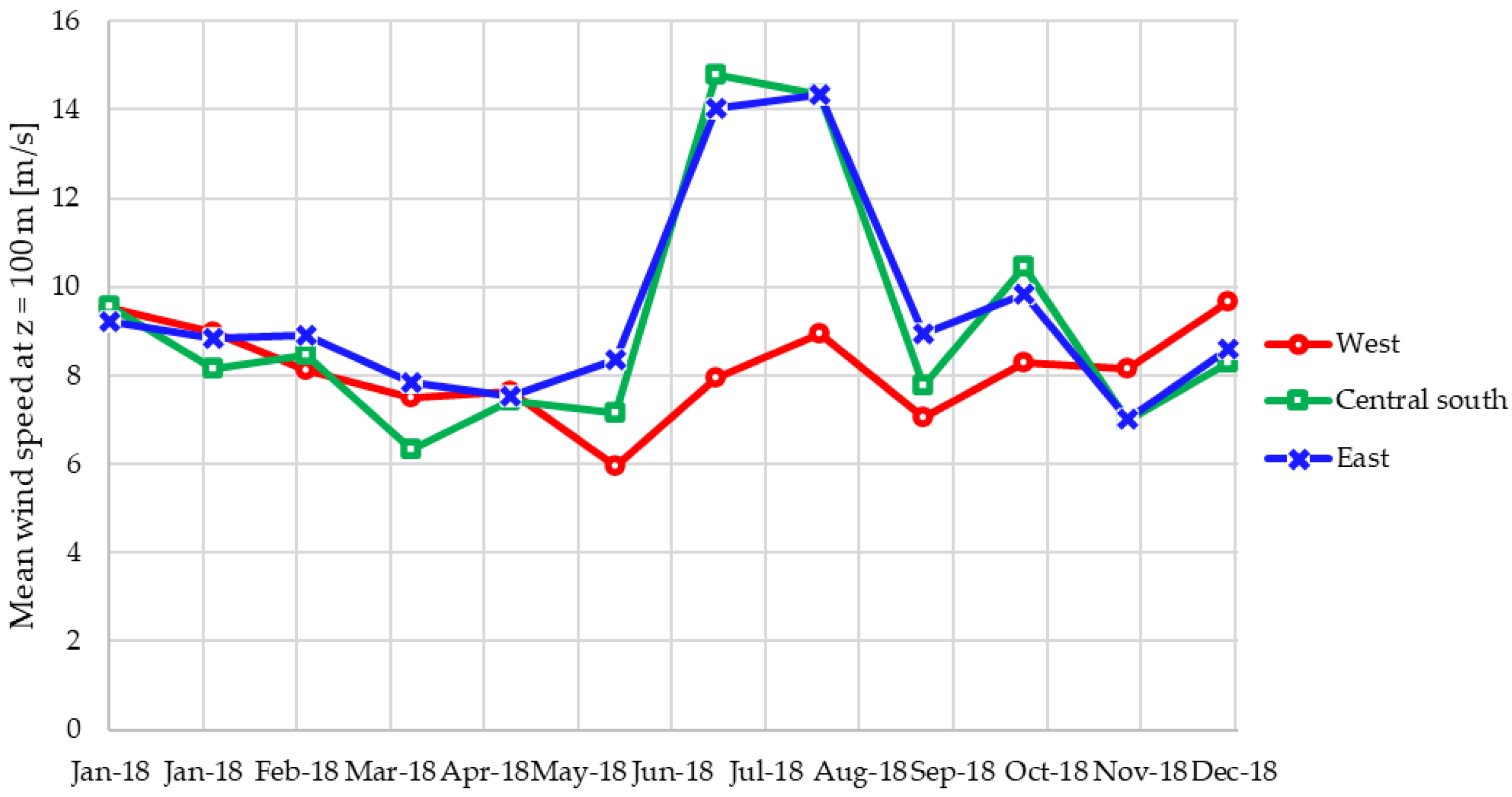
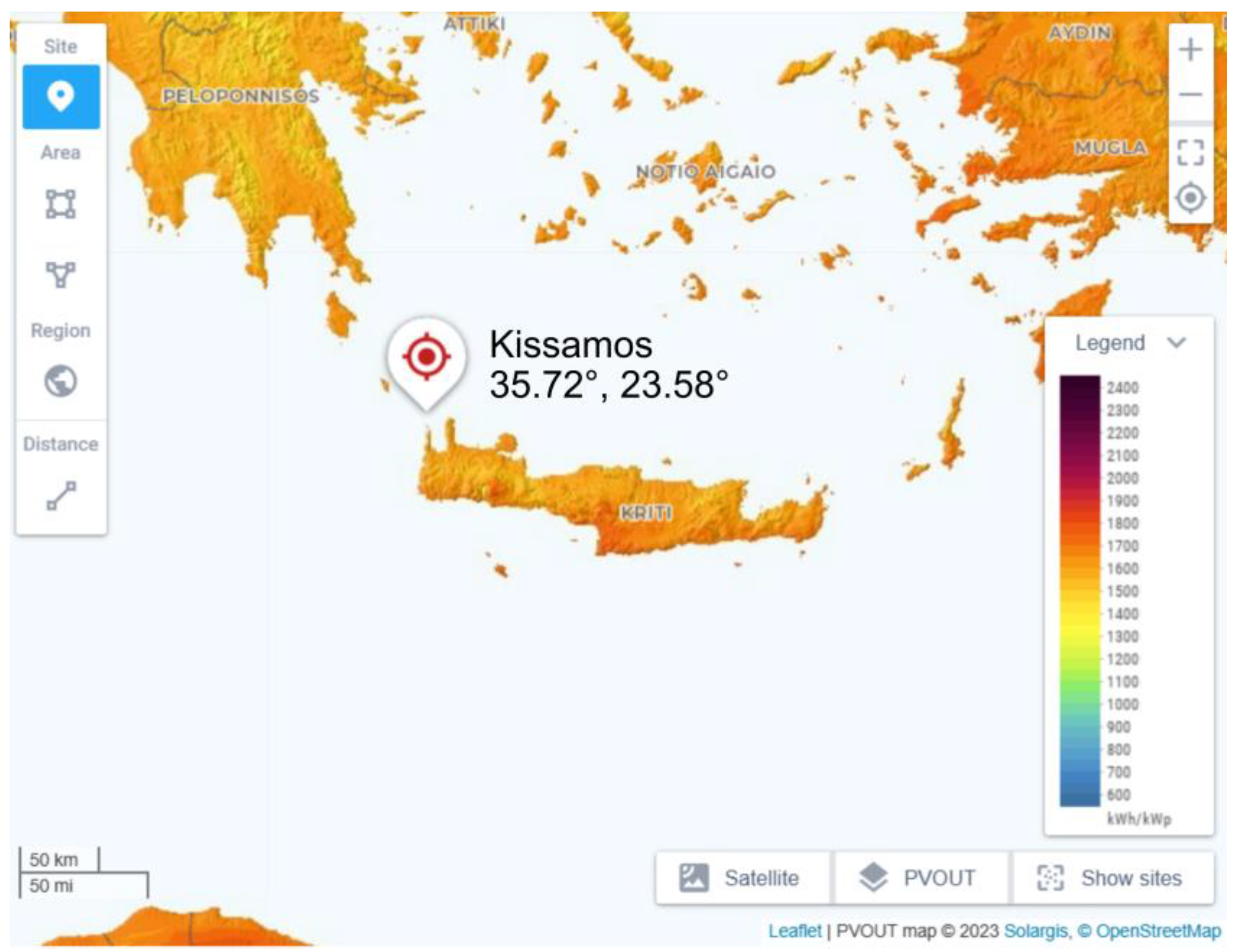
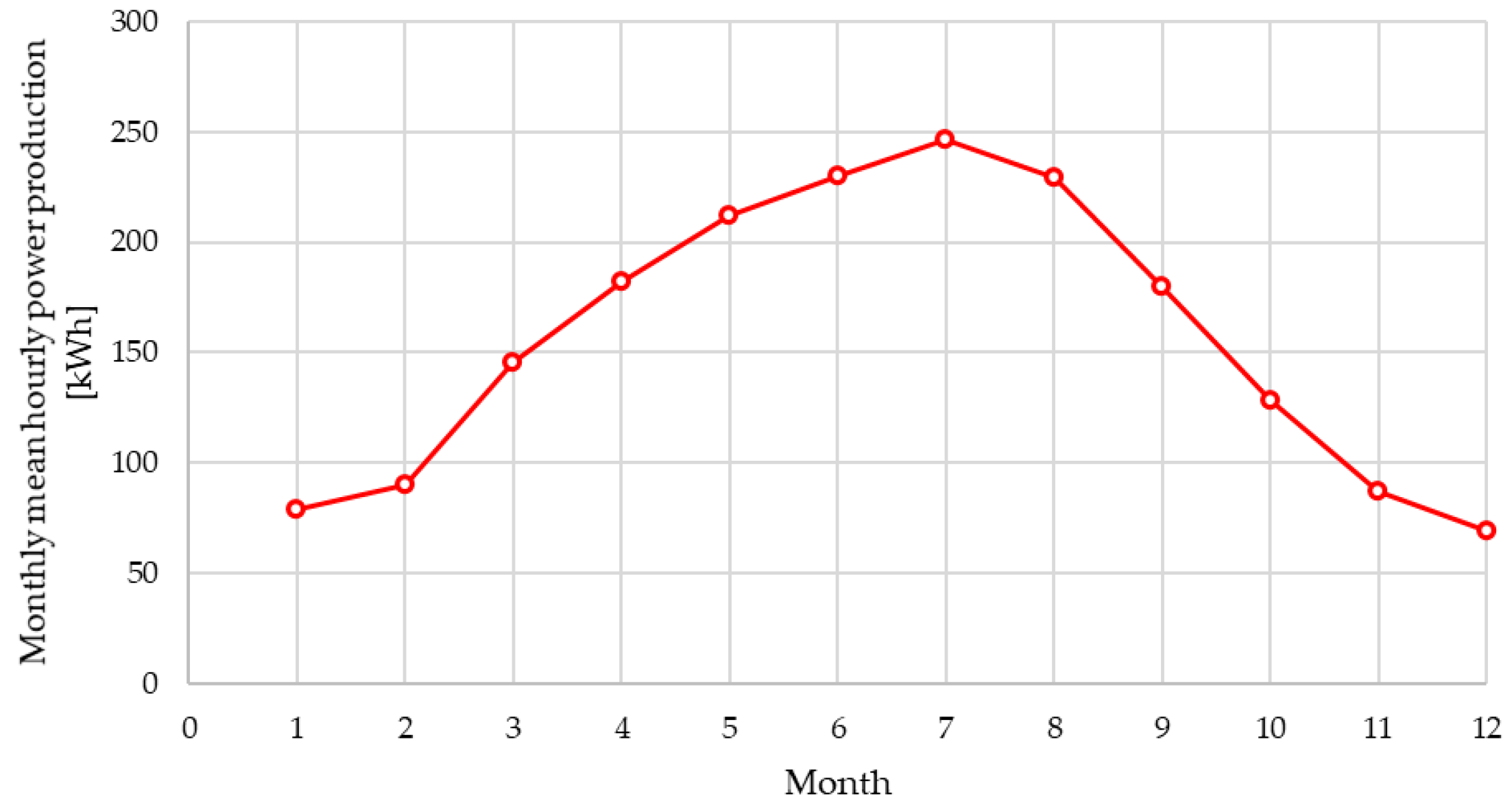
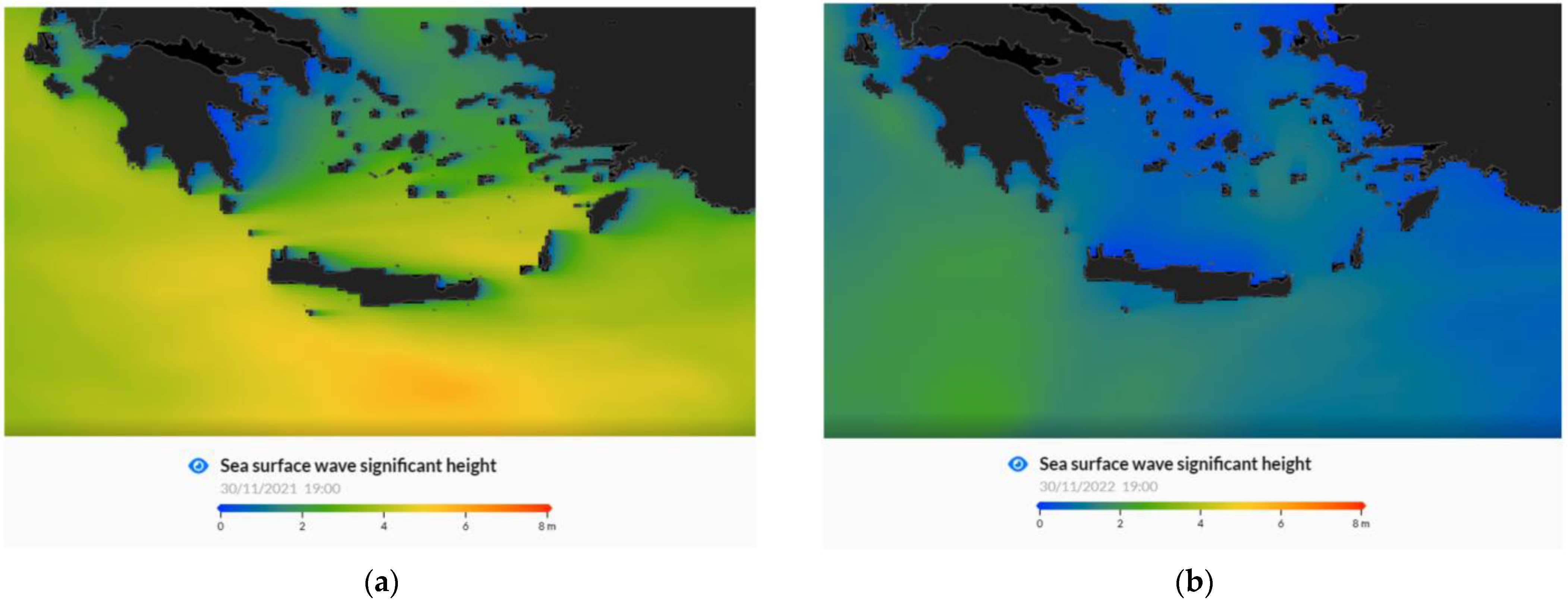
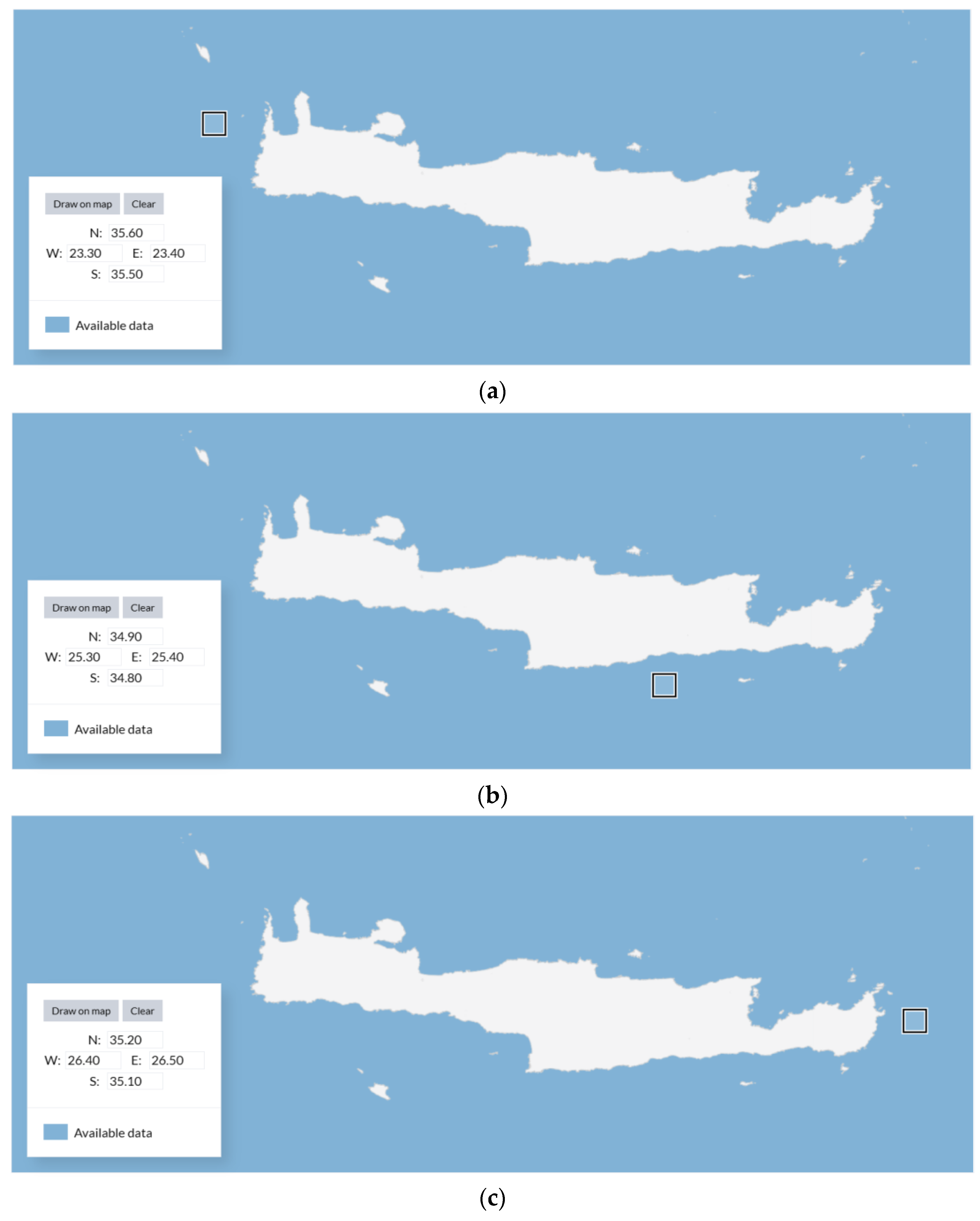
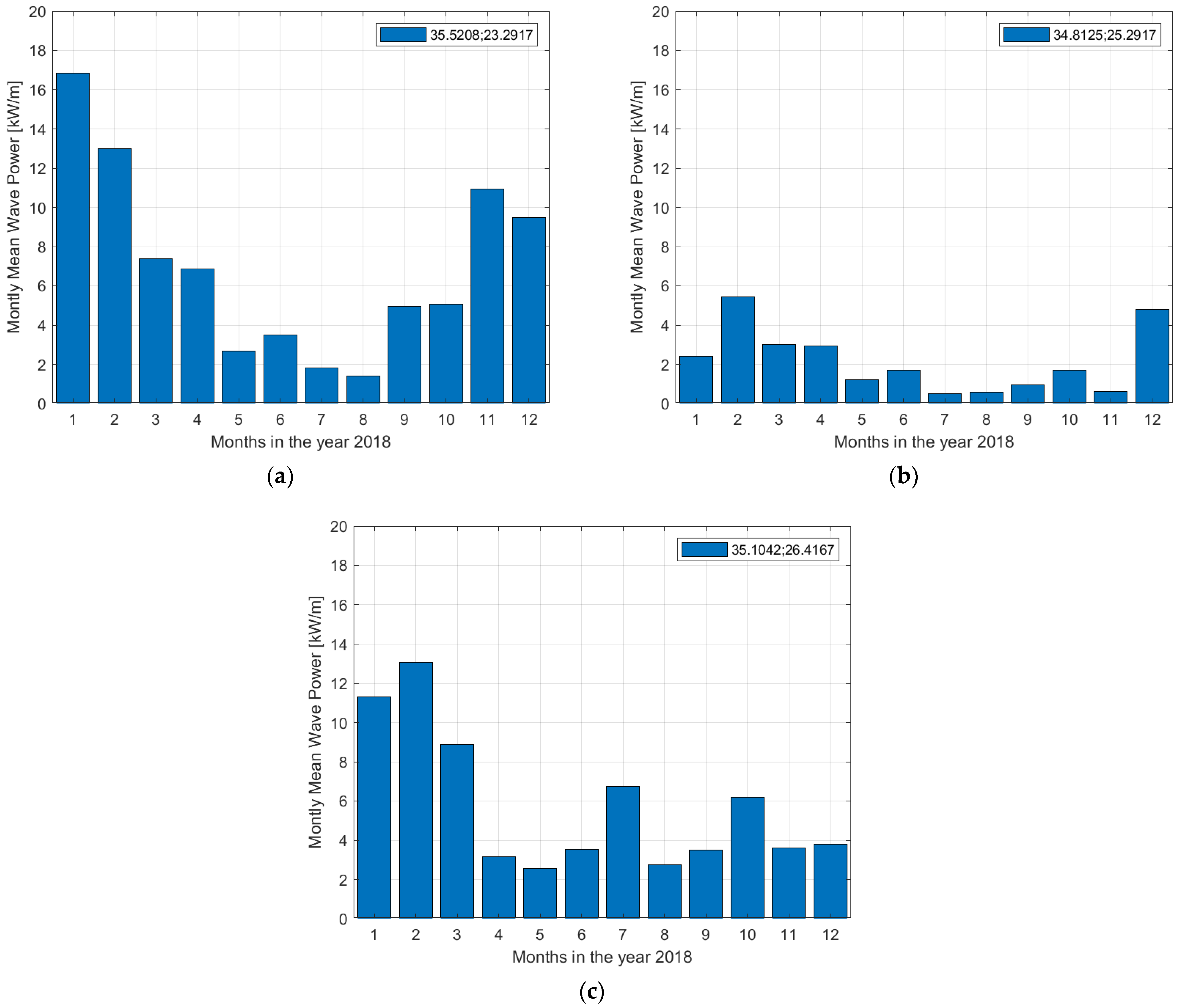
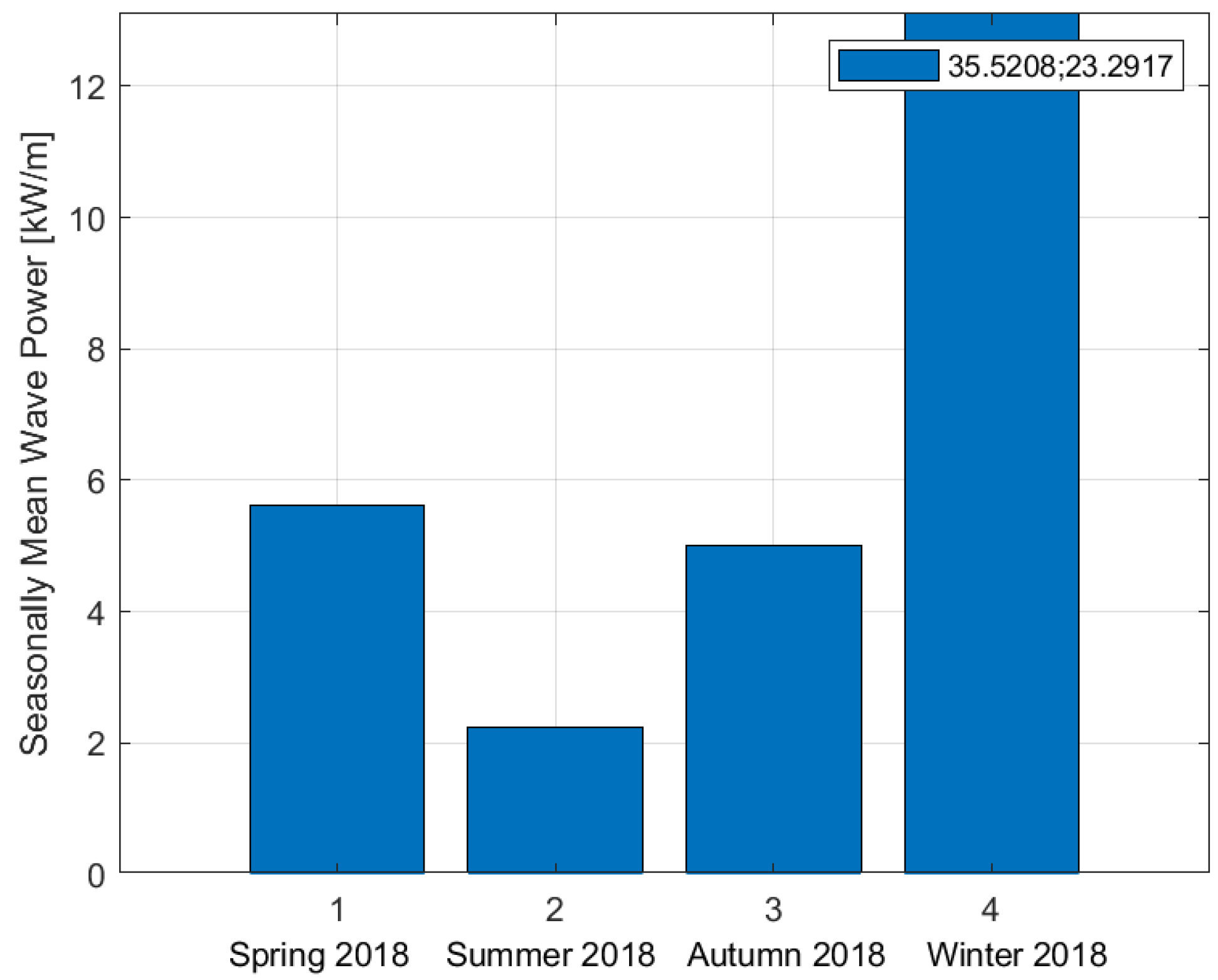
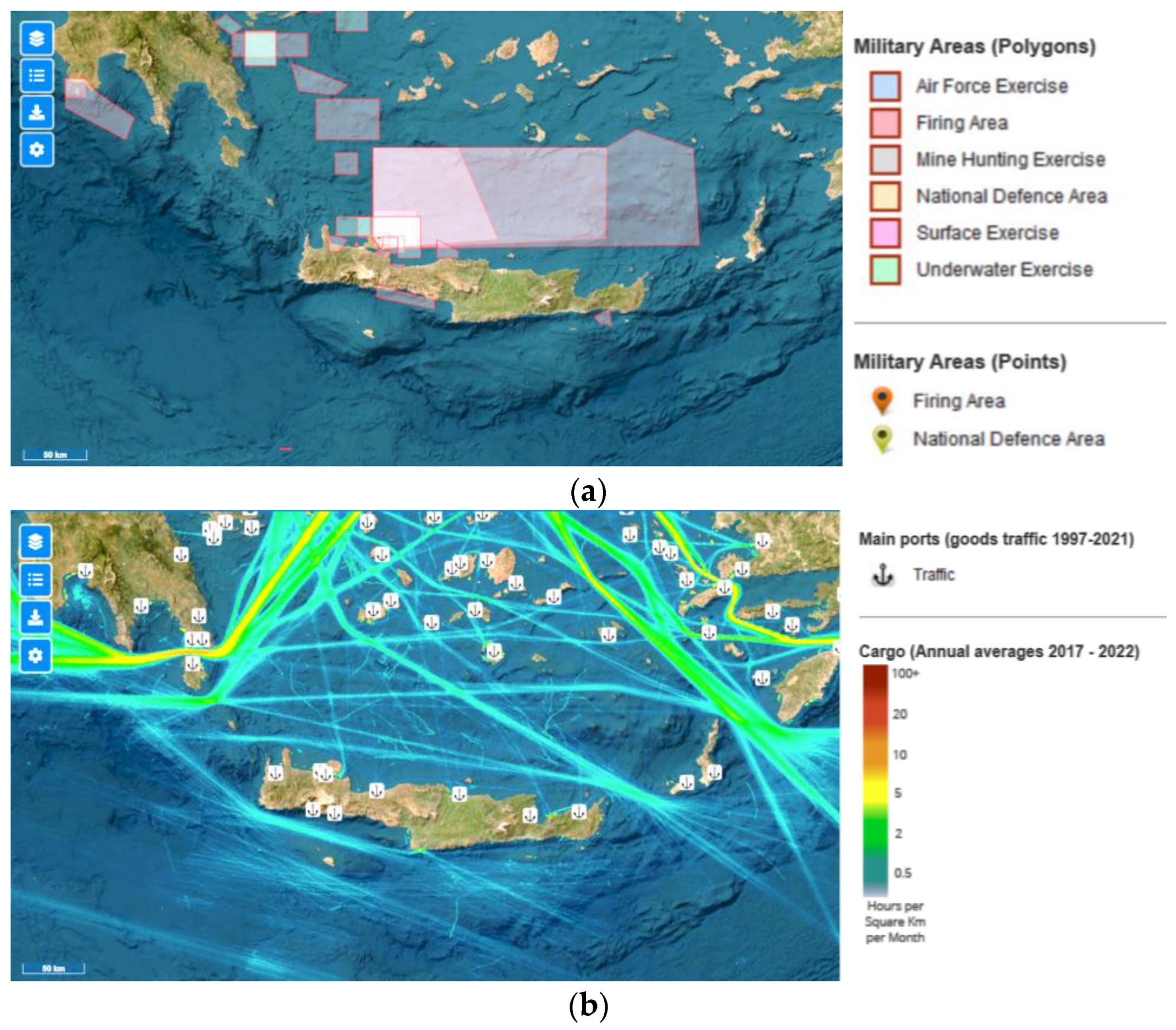
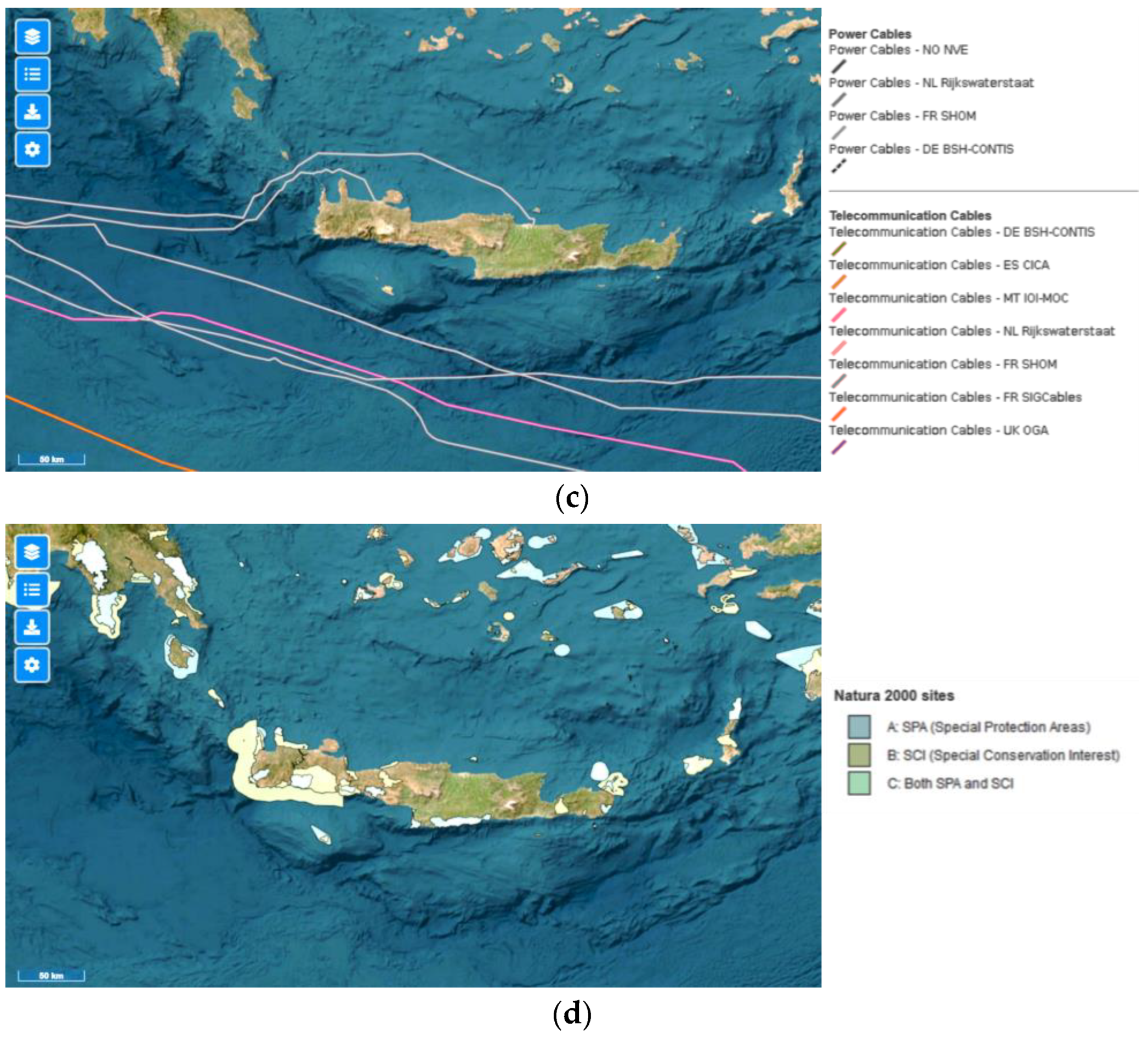

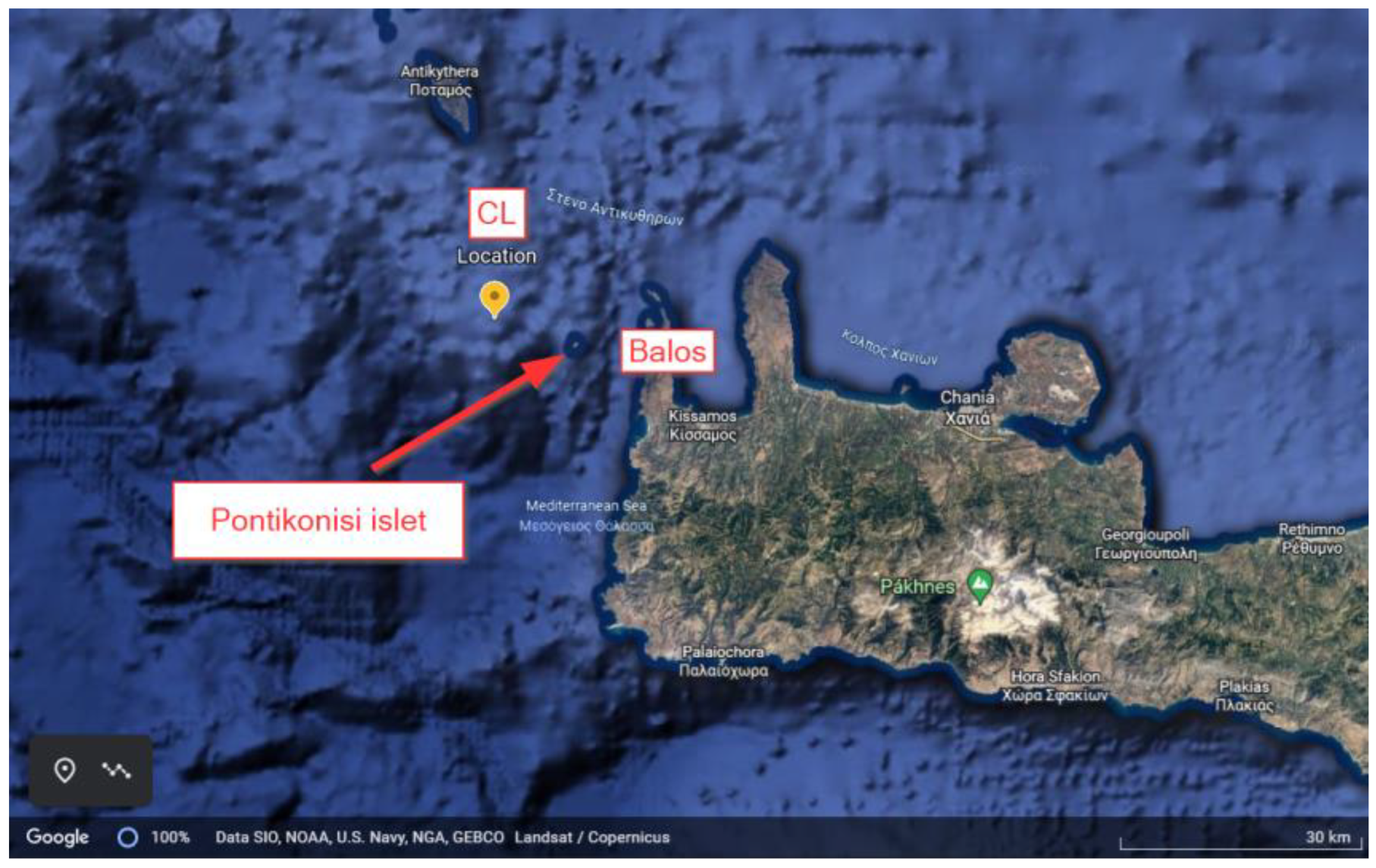


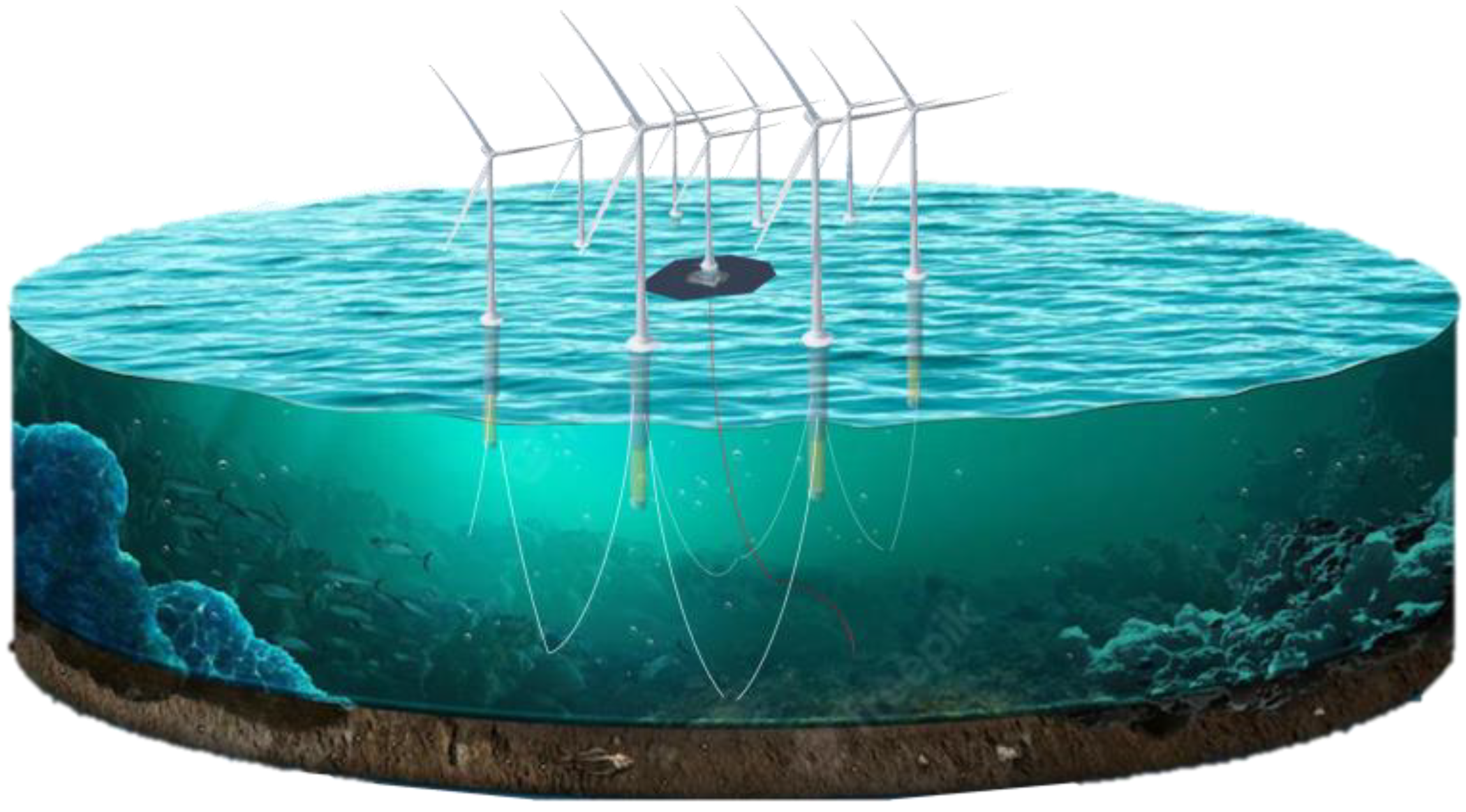
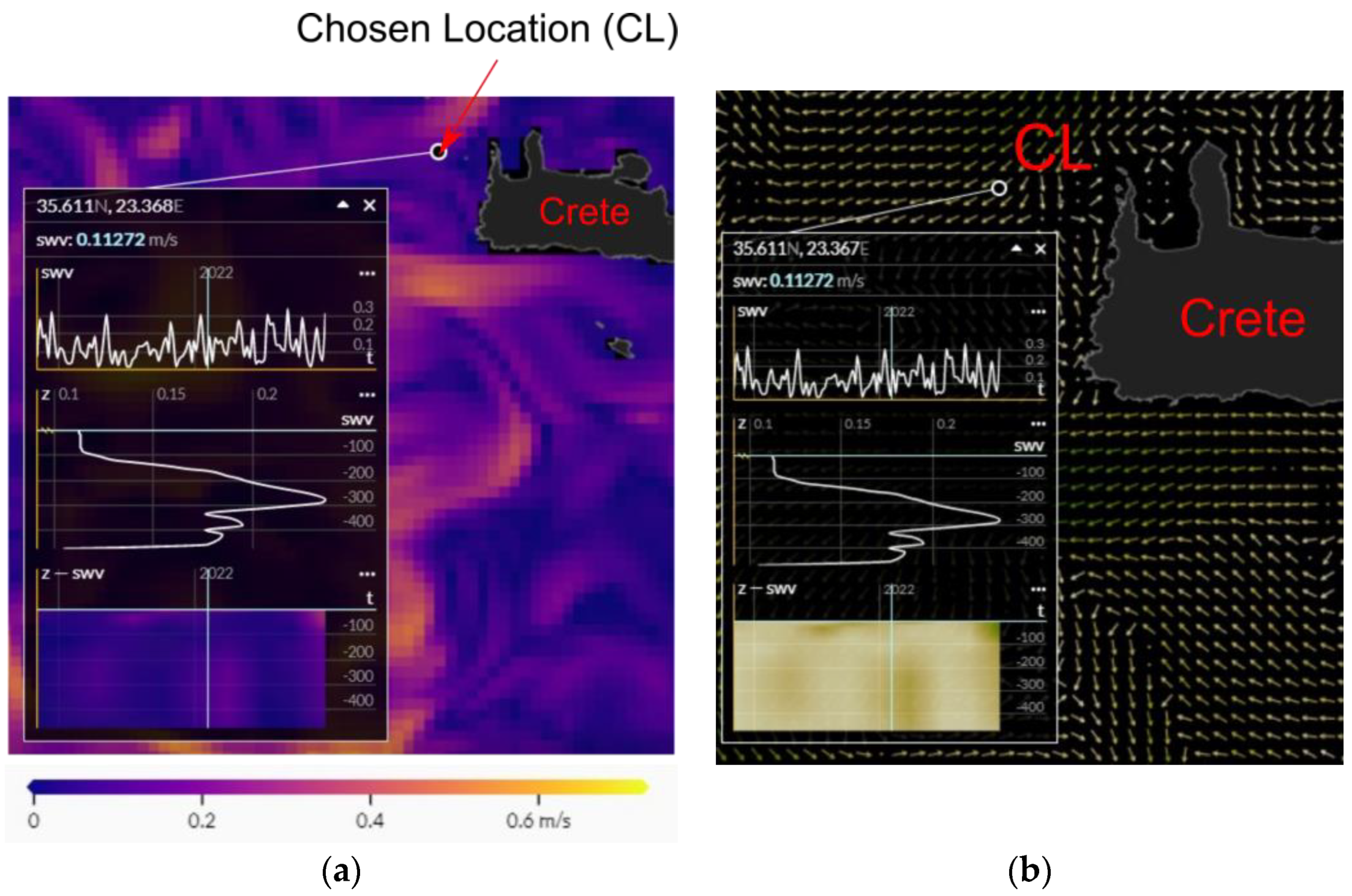
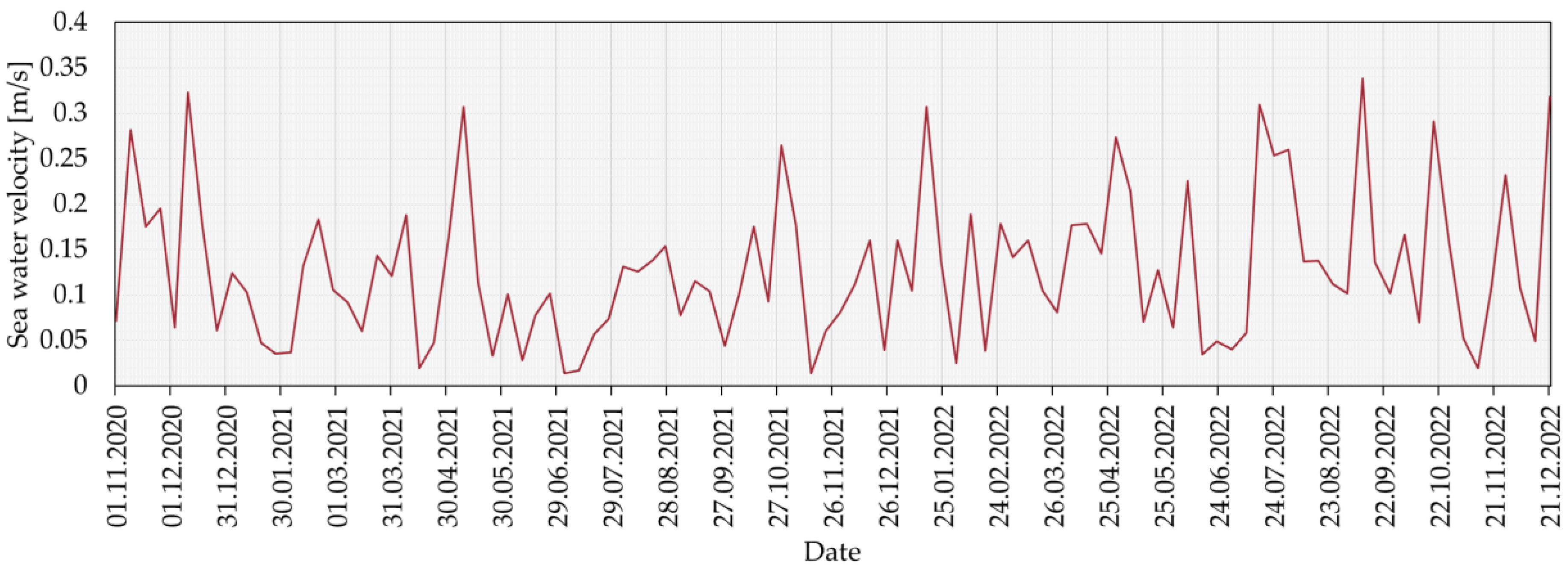
| Region | Latitude, Longitude [°] | Climate Mean Wind Speed [m/s] | Climate Mean Power Density [W/m2] | Wind Power Class |
|---|---|---|---|---|
| West | 35.59, 23.35 | 8.8 | 719 | 6 |
| Central south | 34.85, 25.33 | 9.2 | 973 | 6 |
| East | 35.11, 26.47 | 9.7 | 937 | 6 |
| Region | Latitude Range | Longitude Range |
|---|---|---|
| West | 35.50–35.60 | 23.30–23.40 |
| Central south | 34.80–34.90 | 25.30–25.40 |
| East | 35.10–35.20 | 26.40–26.50 |
Disclaimer/Publisher’s Note: The statements, opinions and data contained in all publications are solely those of the individual author(s) and contributor(s) and not of MDPI and/or the editor(s). MDPI and/or the editor(s) disclaim responsibility for any injury to people or property resulting from any ideas, methods, instructions or products referred to in the content. |
© 2023 by the authors. Licensee MDPI, Basel, Switzerland. This article is an open access article distributed under the terms and conditions of the Creative Commons Attribution (CC BY) license (https://creativecommons.org/licenses/by/4.0/).
Share and Cite
Kurniawati, I.; Beaumont, B.; Varghese, R.; Kostadinović, D.; Sokol, I.; Hemida, H.; Alevras, P.; Baniotopoulos, C. Conceptual Design of a Floating Modular Energy Island for Energy Independency: A Case Study in Crete. Energies 2023, 16, 5921. https://doi.org/10.3390/en16165921
Kurniawati I, Beaumont B, Varghese R, Kostadinović D, Sokol I, Hemida H, Alevras P, Baniotopoulos C. Conceptual Design of a Floating Modular Energy Island for Energy Independency: A Case Study in Crete. Energies. 2023; 16(16):5921. https://doi.org/10.3390/en16165921
Chicago/Turabian StyleKurniawati, Ika, Beatriz Beaumont, Ramon Varghese, Danka Kostadinović, Ivan Sokol, Hassan Hemida, Panagiotis Alevras, and Charalampos Baniotopoulos. 2023. "Conceptual Design of a Floating Modular Energy Island for Energy Independency: A Case Study in Crete" Energies 16, no. 16: 5921. https://doi.org/10.3390/en16165921
APA StyleKurniawati, I., Beaumont, B., Varghese, R., Kostadinović, D., Sokol, I., Hemida, H., Alevras, P., & Baniotopoulos, C. (2023). Conceptual Design of a Floating Modular Energy Island for Energy Independency: A Case Study in Crete. Energies, 16(16), 5921. https://doi.org/10.3390/en16165921








